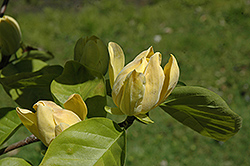It's all about ...
plants

Brenda Magnolia
Magnolia acuminata 'Brenda'
Height: 20 feet
Spread: 15 feet
Sunlight:
![]()
![]()
Hardiness Zone: 4a
Other Names: Cucumber Magnolia
Description:
A more compact and slower growing variety of this native tree; stunning bright yellow flowers are extraordinary, even though they are small; better suited to areas where limited space is a consideration
Ornamental Features
Brenda Magnolia has fragrant yellow cup-shaped flowers held atop the branches from late spring to early summer, which are interesting on close inspection. It has dark green deciduous foliage. The pointy leaves turn coppery-bronze in fall. The fruits are showy rose pods displayed in early fall.
Landscape Attributes
Brenda Magnolia is a deciduous tree with an upright spreading habit of growth. Its relatively coarse texture can be used to stand it apart from other landscape plants with finer foliage.
This is a relatively low maintenance tree, and is best pruned in late winter once the threat of extreme cold has passed. Deer don't particularly care for this plant and will usually leave it alone in favor of tastier treats. It has no significant negative characteristics.
Brenda Magnolia is recommended for the following landscape applications;
- Accent
- Shade
Planting & Growing
Brenda Magnolia will grow to be about 20 feet tall at maturity, with a spread of 15 feet. It has a low canopy with a typical clearance of 3 feet from the ground, and is suitable for planting under power lines. It grows at a slow rate, and under ideal conditions can be expected to live for 60 years or more.
This tree does best in full sun to partial shade. It requires an evenly moist well-drained soil for optimal growth, but will die in standing water. It is not particular as to soil type, but has a definite preference for acidic soils. It is quite intolerant of urban pollution, therefore inner city or urban streetside plantings are best avoided. Consider applying a thick mulch around the root zone in winter to protect it in exposed locations or colder microclimates. This is a selection of a native North American species.
This plant is not reliably hardy in our region, and certain restrictions may apply; contact the store for more information.
